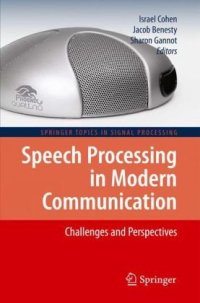
Ebook: Speech Processing in Modern Communication: Challenges and Perspectives
- Tags: Signal Image and Speech Processing, User Interfaces and Human Computer Interaction, Acoustics, Communications Engineering Networks
- Series: Springer Topics in Signal Processing 3
- Year: 2010
- Publisher: Springer-Verlag Berlin Heidelberg
- Edition: 1
- Language: English
- pdf
More and more devices for human-to-human and human-to-machine communications require some sophisticated algorithms. This is due to the fact that the acoustic environment in which we live in and communicate is extremely challenging. More than ever, the fundamental problems of acoustic echo cancellation, interference and noise suppression, and dereverberation need to be tackled rigorously.
Researchers from diverse fields of speech processing contributed chapters addressing their specific topic of study, where research is very active. The topics include:
- speech enhancement in transient-noise and reverberant environments,
- single-channel blind source separation of speech and music signals,
- acoustic echo cancellation in double-talk scenarios,
- linear and nonlinear system identification in the short-time Fourier transform domain for acoustic echo cancellation,
- identification of the relative transfer function between sensors for beamforming in reverberant environments,
- microphone arrays in noisy reverberant environments,
- beamforming methods for spherical microphone arrays, and
- broadband source localization.
This book has been edited for engineers, researchers, and graduate students who work on speech processing for communication applications. We hope that the readers will find many new and interesting concepts that are presented in this text useful and inspiring.
Modern communication devices, such as mobile phones, teleconferencing systems, VoIP, etc., are often used in noisy and reverberant environments. Therefore, signals picked up by the microphones from telecommunication devices contain not only the desired near-end speech signal, but also interferences such as the background noise, far-end echoes produced by the loudspeaker, and reverberations of the desired source. These interferences degrade the fidelity and intelligibility of the near-end speech in human-to-human telecommunications and decrease the performance of human-to-machine interfaces (i.e., automatic speech recognition systems). The proposed book deals with the fundamental challenges of speech processing in modern communication, including speech enhancement, interference suppression, acoustic echo cancellation, relative transfer function identification, source localization, dereverberation, and beamforming in reverberant environments. Enhancement of speech signals is necessary whenever the source signal is corrupted by noise. In highly non-stationary noise environments, noise transients, and interferences may be extremely annoying. Acoustic echo cancellation is used to eliminate the acoustic coupling between the loudspeaker and the microphone of a communication device. Identification of the relative transfer function between sensors in response to a desired speech signal enables to derive a reference noise signal for suppressing directional or coherent noise sources. Source localization, dereverberation, and beamforming in reverberant environments further enable to increase the intelligibility of the near-end speech signal.